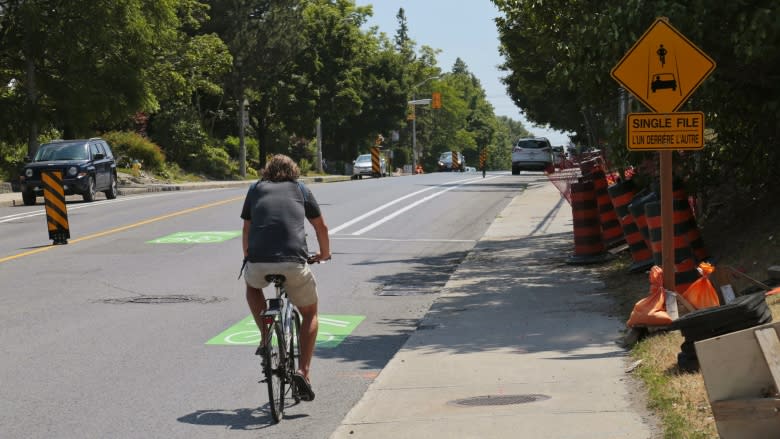Mayor rules out changes to Holland Avenue this year
Ottawa Mayor Jim Watson said there will be no changes to the new bike route along Holland Avenue — at least this year.
"We've got this system in place. Let us go through one season and if there are changes that have to be made, obviously from a safety point of view, we'll do that," Watson said.
The city redesigned the 500-metre stretch between Byron Avenue and Kenilworth Street last week, as part of its two-year plan to replace the Harmer Avenue pedestrian bridge over Highway 417 — a few blocks northeast of the Ottawa Hospital's Civic campus.
Pedestrians and cyclists that typically use the Harmer bridge to bypass the 417, now have to use the adjacent Holland Avenue.
Cyclists are guided along the route by "super-sharrows" — green road markings with a bicycle and two chevrons, set in the middle of the road.
The idea is to encourage cyclists to "take the lane" by riding on top of the sharrows, with drivers expected to follow in a single file.
Sharrows are nothing new to the city, Watson said.
"We have sharrows — for instance — in Hintonburg right now that are well used. Unfortunately, we can't have a segregated lane on every single street."
Plans for the detour initially included temporary segregated bike lanes on either side of Holland Avenue, but that design was quashed after residents complained it would eliminate street parking.
All parties concerned
But both cyclists and drivers who use Holland Avenue have expressed concerns about the detour.
The City of Ottawa has already lowered the speed limit to 30 km/h along the 500-metre detour route.
Jordan Moffatt, a cyclist who often commutes to work using Holland Avenue, says the design is an unsettling ride for cyclists, who might worry about holding back drivers.
"It creates conflict. It makes it so that an injury — or a death — is very easy to imagine," he said.
As a driver, John Salvatore says he understands that more and more cyclists are on the road, but he says not everyone behind the wheel is as considerate.
"I find it's dangerous, because most drivers don't have the patience to stay behind the cyclists," he said.
"Who wants to admit that there's a little bit of frustration there in terms of your speed."
One potential alternative would be to build a segregated bidirectional bike lane on one side of Holland Avenue — similar to what's in place on O'Connor Street in the city's downtown — which we leave one side of of the street open for parking.
Watson said the city "may look at [bidirectional] lanes next year" but is confident in the current system in place.
"What we came up with was what I think is a compromise that our traffic engineers and traffic planners tell me is a safe alternative."



